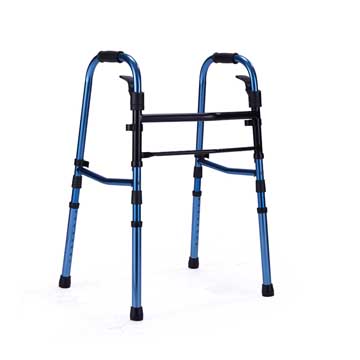Jul. 28, 2021
Some user doesn't overbalance when they walk but need regular breaks when traveling around, walking aids can provide them with some extra support to help them stay safe and confident. Since there are many choices between the walking frames and rollators, how do you recommend the right one?
Walking frames provide support for people as they move around indoors and outdoors. In addition, they provide stability and balance for people who are less stable on their feet. The design comes with three or four legs (depending on how much stability or assistance the user needs). Each leg has a rubber collar at the bottom that allows you to grip the ground and hold the frame in place. Often, walking frames are used by people who may be recovering from an injury. Or if someone is having trouble balancing while keeping moving.

The wheels are mounted on the front legs for a two-wheeled walking frame, while the back two legs have the same rubber collar. Therefore, the users should tilt the walking frame forward and lift the rear two legs to move, which is ideal for use around the house.
Start with the middle of the feet and hold the frame with both hands. Lifts the walking frames forwards a short distance and then lowers it, with all four tips firmly on the ground. Step forward with one leg while putting your weight through the frame, then place the other leg next. Don't step too far forward. Imagine a line between the two legs behind the frame without putting the heel in front of it.
Rollators come with four wheels. They come in many different configurations and provide stability while still being easy to move. Wheeled walkers require less arm strength, and they can also partially support weight and balance.
Many rollators have optional accessories, such as baskets or shopping bags, trays, and so on. It is vital to remind the user not to put too much extra weight on the frame, affecting its balance. Most styles of rollators can be folded up for storage or transport.
All of them can help a patient move independently or help reduce the chance of falling. However, what's the difference in this case?
The walking frame includes a handle and legs that need to be lifted to move, slowing down the movement and keeping it stable. A hand walker has wheels that are pushed, which means it is faster than using a walking frame. In addition, walkers have features such as manual brakes, and some may even have seats for resting, which means they can be used in various scenarios and situations.
If a person cannot bear weight on one leg or even both legs but can still move and does not need a wheelchair, then a rollator is often the right choice for them. Likewise, rollators are best for people who can walk but need a little help with balance and stability due to their wheels and mobility.
In addition, a rollator saves the user's energy because it does not require them to lift it to move like a walking frame, which in turn allows for faster walking speeds and contributes to a normal gait. If you want to get more information about the best rollators and walking frames, welcome to contact us today or request a quote.